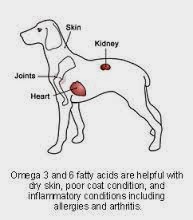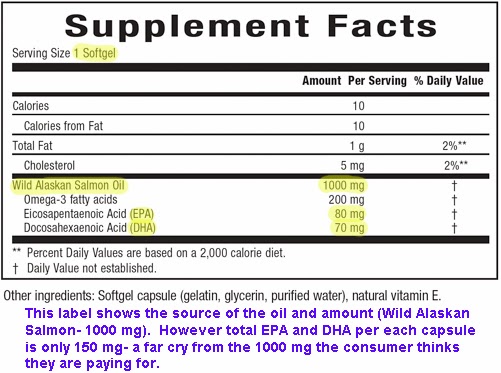 |
| image courtesy of vcahospitals.com |
Many of us have heard of the benefits of fatty acids for some time now. In fact, there is a great deal of good research into these products and their uses. I will attempt to write a synopsis to help you as a possible consumer of fatty acid supplements – either for yourself or for your pet(s). This information is largely based on a recent lecture I attended by Dr. Kenneth Kwochka.
Fatty acids are important sources of energy, but I will focus on their benefits to cells and management of inflammation. Neither Omega 3 or 6 fatty acids can be synthesized in the body. We (and our pets) get fatty acids from our diets.
Omega 6 fatty acids are good for the skin, but bad for inflammation. They are processed in our bodies to Arachidonic Acid (AA). Omega 6 fatty acids are important in skin because they help produce a viable barrier to the environment. Think of the skin as your largest immune organ. It protects you from what you encounter. When your skin is damaged, it is not protecting you. Omega 6 fatty acids keep the skin a viable immune organ. However, the pathway that leads to AA production means that you may be producing too many pro-inflammatory mediators. In other words, the down-side is that you have more tendency toward inflammation. We all know that inflammation is generally bad and is associated with many different disease processes. Too much Omega 6 fatty acids will make any chronic (long-term) disease worse.
Omega 3 fatty acids are good for many of our organs. They are processed by our bodies (though not very efficiently) to two important products – Eicosapentaenoic acid (EPA) and Docosahexaenoic acid (DHA). These two, EPA and DHA can also be found in other food sources such as fish oil. When we get EPA and DHA supplemented in our food or get it in those forms, our bodies can use it much more readily. Summary: EPA and DHA are good, but not easy to get from simply plant sources.
Remember that mention of inflammation? Omega 3 and Omega 6 fatty acids compete for the same enzymes in our bodies, so we have a little battle going on all the time to see if we will end up with more EPA or AA. We typically want more EPA (Omega 3) because of the anti-inflammatory effects.
Now to pets, specifically. If your pet has poor skin and a dull hair coat, then Omega 6 fatty acids will help improve the barrier. However, if there is any inflammation then Omega 6 is not the right choice. If you are unsure, ask your veterinarian. Almost all skin problems will benefit from supplemental Omega 3 fatty acids. These are a more universally safe and appropriate choice. Remember how the skin is a barrier to the outside world? When it is damaged pets get secondary infections (think yeast and bacteria). Those infections lead to an inflammatory response and that is when we as owners typically become aware there is a problem. Omega 3 fatty acids help in cases of allergy (of all types), dry skin, and those skin infections. Omega 3 fatty acids also play a part in the following: nervous system and retinal development in puppies/kittens, joint health, renal function, and cardiovascular function. Puppy and kitten foods have supplemental DHA in them because it is needed for optimal growth and development. Remember to keep your pet’s food in the original packaging and keep it sealed. Fatty acids can oxidize (break down) if left open to the air. If your pet has joint disease or arthritis, Omega 3 fatty acid supplementation will help you reduce the amount of anti-inflammatory medications (drugs) you have to give and will help relieve your pet’s pain.
How, then, do we shop for the right product? It all boils down to being able to read the label and some products do not want you to know, ultimately, the final numbers. Just like human supplements, pet supplements are difficult to compare and are poorly regulated. It is important to look at the numbers that matter – that is, concentration of EPA in the product. There are several brands of veterinary supplements that are Omega 3’s. I will not list them here, but I was shocked and disappointed to learn that the one I have been using for the past 5 years has the lowest amount of EPA in it when compared to the others. As with human supplements, bio-availability is important and how much end product the pet gets is what truly matters. I am researching a switch in my recommendations for this primary reason: the label that says how much I should give my pet is not accurate based on the research that exists and I have been giving my pet 1/3 the dose I should have. I can’t wait to see what happens when I make the correction!
Here’s a great example I found online via Loving Touch Animal Center:
Talk to your vet if you feel that Omega 3 fatty acids will help your pet, and remember to give the dose they recommend, not necessarily what is on the bottle.
Dr. Amy Hellard
West Chester Veterinary Care
www.westchesterveterinarycare.com






